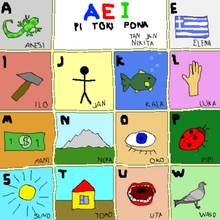Updated jan Pije's lessons/Lesson 2 Pronunciation
Pronunciation & the Alphabet
There are fourteen letters in the Toki Pona alphabet: nine consonants (j k l m n p s t w), and five vowels (a e i o u).
Consonants
Except for j, all the consonants are pronounced like any person who speaks a European language would expect them to be.
| letter | pronounced as in |
|---|---|
| k | kill |
| l | let |
| m | met |
| n | net |
| p | pit |
| s | sink |
| t | too |
| w | wet |
| j | yet |
As you might have noticed, j in Toki Pona isn't pronounced like the English j. Instead, it's always pronounced just like the letter y in English. Languages such as Esperanto also have this feature; however, if you've never studied a language that uses j like this, make sure to be careful so that you pronounce it right. If you see j, pretend that it's y.
Vowels
Toki Pona's vowels are quite unlike English's. Whereas vowels in English are quite arbitrary and can be pronounced tons of different ways depending on the word, Toki Pona's vowels are all regular and never change pronunciation. Now the only hard part is learning the vowels and being able to apply them.
If you're familiar with Italian, Spanish, Esperanto, or certain other languages, then your work is already cut out for you. The vowels are the same in Toki Pona as they are in these languages. Study this chart.
| letter | pronounced as in |
|---|---|
| a | father |
| e | met |
| i | peel |
| o | more |
| u | food |
Now that you've learned the alphabet, check out this neat little picture by Lament, a speaker of Toki Pona. It shows fourteen different Toki Pona words, each one beginning with one of the letters from the Toki Pona alphabet; there is also a picture of what each word represents.

(Note that Elena, the Toki Pona for "Greek," is not an actual Toki Pona word from the dictionary. It was used because there are no nouns in the Toki Pona dictionary that begin with e.)
The More Advanced Stuff
If you feel that you've adequately learned how to pronounce Toki Pona words, then you've learned the essential stuff that you need to know for the time being. However, there are still things to learn. If learning the pronunciation was difficult for you, then I'd recommend that you not study the stuff below right now; however, this information is still important to anyone who really wants to learn Toki Pona, so you'll need to come back to it at a later time.
If the pronunciation lesson wasn't too hard for you and you want to learn more, continue reading.
1. All official Toki Pona words (which are all the words such as toki and pakala that can be found in the Toki Pona to English dictionary) are never capitalized. (Yes, they are lowercase even at the beginning of the sentence!)
2. The only time that capital letters are used is when you are using unofficial words, like the names of people or places or religions. A few examples: jan Kalisija li pona. (Kalisija, the name of a person, is the only word capitalized in this sentence.) -- ma Elopa li suli. (Europe is not an official Toki Pona word, so it is capitalized.)
3. Because Toki Pona has so few consonants, the exact sound which is spoken can be quite free and flexible. In addition to the pronunciations that you learned earlier in this lesson, here's a quick list of a few of the alternate pronunciations that certain consonants can have:
- p -- as in bit
- t -- as in do
- k -- as in gill
- s -- as in zinc
4. Syllables in Toki Pona follow this pattern: consonant + vowel + optional n. The consonant can be left out if the syllable that you're dealing with is the first syllable in a word (for example, there is no initial consonant in ali or unpa). --- The final n can not be used if the next syllable of the word begins with m or n. --- There are four combinations which are not allowed, due to the difficulty in either hearing or speaking them. These are: ji, ti, wo, and wu.
5. Accent is always on the first syllable.